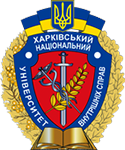Subject matter of crime violation of the procedure for transplantation of human anatomical materials established by law
Abstract
The article is devoted to highlighting the topical issues related to the subject matter of the crime violation of the procedure for transplantation of human anatomical materials established by law. Based on the analysis of Ukrainian legislation and scientific works of Ukrainian scientists, the author offers own vision of the issue related to the subject matter of the analysed crime, namely: the author considers the maximum permissible terms of transportation and optimal storage periods for such organs as heart, kidneys, liver, left and right lobes of the liver, lung, and homograft. In addition, the author considers the definition of “anatomical materials”, expresses an opinion on the concept of transplantation of human anatomical material and offers own vision on the subject matter of the analysed crime. The author proposes to: 1) to introduce to Part 1 of Article 143 of the Criminal Code of Ukraine a qualifying feature i.e., the prohibition to use human anatomical materials which are not healthy or unsuitable for transplantation with violation of the term of their use; 2) to restate paragraph 1 of Part 1 of Article 299 of the Criminal Code of Ukraine as follows: “Cruel treatment of animals belonging to vertebrates, including homeless animals, violation of animals transportation rules, if such actions resulted in bodily injury, mutilation or death of an animal, illegal removal of organs or tissues from live animals, that belong to the vertebrates, setting animals against each other, committed for hooligan or mercenary motives, as well as propaganda, public calls for actions that have signs of cruelty to animals, distribution of materials calling for such actions – …”. It is also advisable to include DNA and DNA fragments in the list of human anatomical material, and to approve a separate list of human cells allowed for extraction, namely DNA and DNA fragments, in the relevant order of the Ministry of Health of Ukraine. To include DNA and DNA fragments in the list of human anatomical material in the Law of Ukraine “On the Application of Transplantation of Human Anatomical Materials” dated 17 May 2018 No. 2427-VIII and to amend the subject matter of the crime in respect of DNA and DNA fragments.
Downloads
References
Azarov, D. S., Hryshchuk, V. K., Savchenko, А. V. et al. (2016). Scientific and applied commentary to the Criminal Code of Ukraine (О. М. Dzhuzha, А. V. Savchenko, V. V. Cherniei, Eds). Yurinkom Inter.
Chebotarova, H. V. (2003). Criminal legal problems of transplantation of human organs or tissues and blood donation [Candidate dissertation, Koretsky Institute of State and Law of National Academy of Science of Ukraine].
Glazier, A. K. (2018). Organ Donation and the Principles of Gift Law. Clinical Journal of the American Society of Nephrology, 13(8), 1283–1284. https://doi.org/10.2215/CJN.03740318.
Hlushko, L. V., Fedorov, S. V., Skrypnyk, I. M. et al. (2019). Internal diseases. Ivano-Frankivsk.
Hrynchak, S. V. (2006). Violation of the procedure established by law for transplantation of human organs or tissues: grounds for criminal liability [Candidate dissertation, Yaroslav Mudryi National Law Academy of Ukraine].
Hryshchuk, V. K. (2006). Criminal law of Ukraine. General part. In Yure.
Matyshevskyi, P. S., Andrushko, P. P., & Shapchenko, S. D. (Eds). (1997). Criminal law of Ukraine. General Part. Yurinkom Inter.
Melnyk, M. I., & Khavroniuk, M. I. (Eds). (2003). Scientific and applied commentary to the Criminal Code of Ukraine. Attika.
Melnyk, M. I., & Khavroniuk, M. I. (Eds). (2018). Scientific and applied commentary to the Criminal Code of Ukraine. Dakor.
Myslyva, O. O. (2012). Object and subject of criminal offenses in the field of transplantation. Scientific Bulletin of Dnipropetrovsk State University of Internal Affairs, 1, 450–459.
Panov, M. M. (2009). Criminal liability for illegal actions with transfer documents; payment cards and other means of access to bank accounts (V. I. Borisov, Ed.). Pravo.
Potebenko, M. O., & Honcharenko, V. H. (Eds). (2001). Scientific and practical commentary to the Criminal Code of Ukraine (Part 2). Forum.
Shaheen, F. A. (2009). Organ donation in the Middle East countries. Ethnicity & Disease, 19. https://www.researchgate.net/publication/26255704_Organ_donation_in_the_Middle_East_countries.
Shulga, O. M., Pavlikovskii, V. I., & Vapsva, Yu. A. (2008). Criminal law of Ukraine: main questions and answers. Bereka-Nova.
Tatsii, V. Ya., Borysov, V. I., Tiutiuhin, V. I. et al. (2020). Criminal law of Ukraine (V. Ya. Tatsii, V. I. Borysov, V. I. Tiutiuhin, Eds). Right.
Copyright (c) 2023 Yu. O. Tkach

This work is licensed under a Creative Commons Attribution 4.0 International License.



